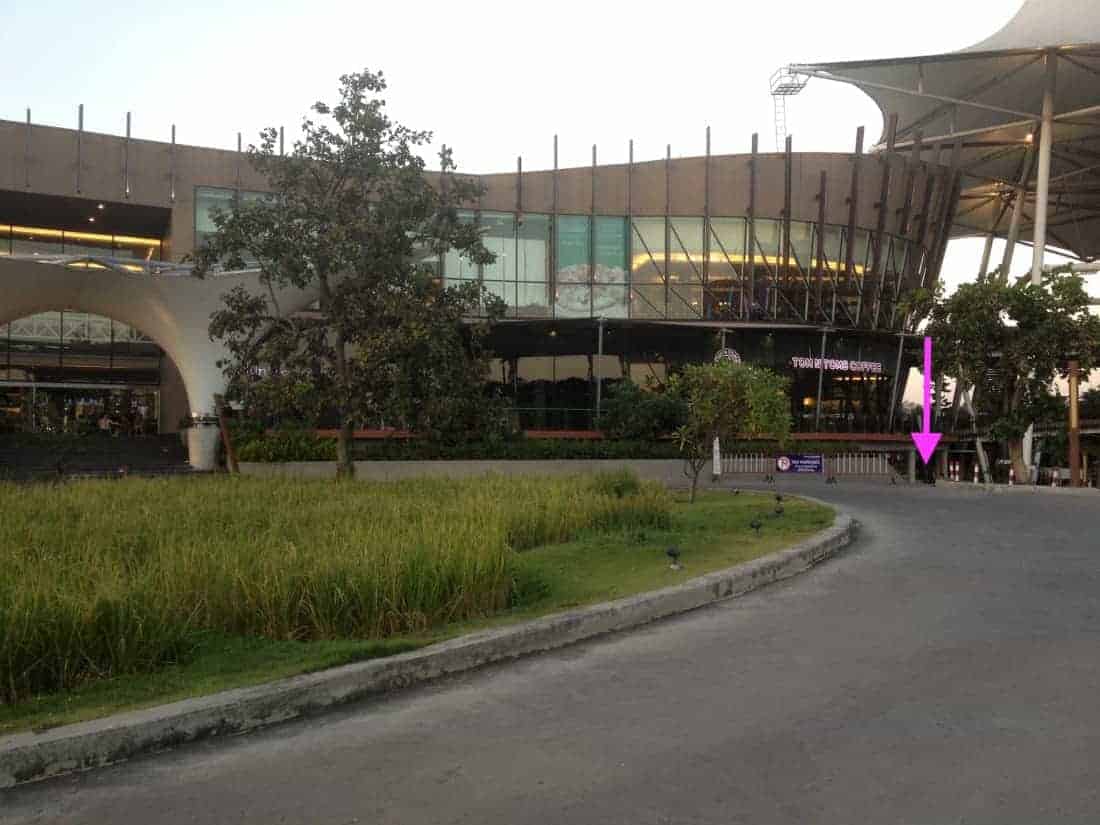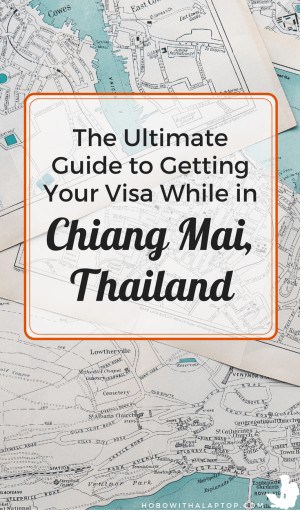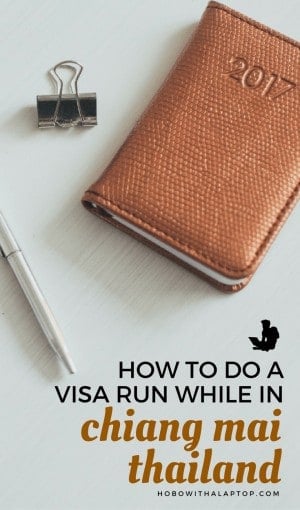

 Thai Visas Explained
Thai Visas Explained
In this updated for 2020 Thailand visa guide, you’ll learn all about visa requirements, visa runs to Laos from Chiang Mai, border runs, visa extensions, the new Chiang Mai Immigration location, and more.
This Chiang Mai ‘visa run’ guide is excerpt from Digital Nomad Escape Plan: From Cubicle to Chiang Mai, Thailand. Pick it up for free, and hold onto it for later.
Related: How to Become a Digital Nomad, Step-by-Step
1. Chiang Mai Digital Nomad: Visa Basics
For first-time Chiang Mai digital nomads, Thailand’s visa process can seem a bit complicated and overwhelming. Before I show you how to navigate the Thai visa process, let’s lay out the groundwork and start with the basics.
Digital nomads aren’t going anywhere
Especially Chiang Mai digital nomads
Thailand Visa Types Suitable for Digital Nomads
Once you’ve acquired your passport, you will need to select the appropriate visa (preferably in your home country before arriving to Thailand).
There are 5 primary visas available to foreigners:
- Tourist Visa (TR)
- Education Visa (ED)
- Business Visa (B)
- Dependent Visa (O)
- Retirement Visa (O-A)
There are really only two visa designations you will need to consider to start out as a Digital Nomad and they are: Tourist (TR) or Education (ED).
Your Only Deciding Factor
Can you handle the commitment of learning either the Thai language or self defense in Chiang Mai, or is a commitment like this not ideal for you at this time?
If it’s a commitment to learn a language or Muay Thai classes you want, get an education visa and feel free to jump ahead in the book.
If you need to keep your head down and focus on your income (i.e. no education visa), please continue to the chapter called “How to Get a Tourist Visa”.
If you would like to learn about retiring in Thailand (over 50), I suggest you take a look at this.
Can I Get a Visa for Thailand in Thailand?
You cannot get a Thai visa in Thailand. A visa exempt stamp you get on arrival if you come without a Tourist visa is not a visa, it’s simply a waiver. If you’re from a country that is eligible for an “on arrival” visa stamp, this is what you get. But it isn’t a visa.
Dreaded Over-stay Fees
If you depart Thailand after the “admitted until” stamp in your passport, each day you are in Thailand past this date will require you to pay a fine of 500 baht per day. The maximum is 25,000 baht and consequences vary to a slap on the wrist to being deported. Keep an eye on your stamps and no matter which visa you choose –be sure to set calendar events in your smart phone.
If you give up your passport for a bike rental, make a calendar alert on your phone.
Get a Visa in Your Home Country Before You Come to Thailand
This is for most of the people who are reading this –you’re likely going to get a Tourist Visa.
You should be able to get a Double-Entry or Triple Entry Tourist Visa in your home country, and that will buy you a lot more time before you need to start making border runs and visa runs.
You can no longer get a double-entry outside your home country, in most cases. Not getting one before you leave your own country is such a wasted opportunity. That means a visa run to Laos, at the time of writing, will only get you a Single Entry visa.
If you plan on being here 3 weeks+ pick up a Double Entry (or even a Triple Entry) visa in your home country. It could save you some serious hassles later, should anything unexpected happen.
Always Get the Latest Information with Sherpa
I’m a big fan of Sherpa and their blog; their app boasts always-up-to-date visa requirements and information, and they can also simplify visa acquisition.
For example, you can watch a video that demonstrates how they can help you apply for a Vietnam visa in 30 seconds here.
From their website; “Sherpa’s mobile apps make it easy to sort out travel documentation. Select your passport(s), and see your travel visa and vaccination requirements at a glance. You can even apply for a visa from your phone. Focus on the beach, not the bureaucracy.”
There’s a small fee for the service, but anything that simplifies the visa process (and prevents you from getting deported) is worthwhile.
You can find their website here.
Special Discounts for Lonely Planet
Check out Lonely Planet’s book shop for more travel information. With our link you are eligible for discounts other people won’t receive, and free shipping on orders over $40 USD (or $50 CAD).
They often run Buy One, Get One deals –so check it out.
Visit Lonely Planet2. How to Get and Maintain a Tourist Visa
The best tourist visa one can get is the one with the longest validity, the lowest risk, and the least responsibility. In this case that’s a “Triple Entry” Tourist visa.
Some countries are not able to pick up a Triple Entry Tourist visa in their home country, in which case I suggest picking up a Double Entry Tourist visa.
To find out if your country even has a Thai consulate/embassy and discover what visas you are eligible for, you can view the updated list at thaiembassy.org.
How Much does a Thai Tourist Visa Cost?
The price varies for each country, and a sample of 3 consulates around the globe state the cost per-entry for a Thai Tourist visa is $40 in United States and Canada, $45 in Australia, and £25 in England. (UK information here).
Considering your Options
- On Arrival Visa (15 to 30 days)
- Double Entry (4 months)
- Triple Entry (6 months)
In the past, travelers would simply leave and come back repeatedly, obtaining many “on arrival” visas in a row however that is no longer a guarantee.
Back-to-Back Visas
If you’re going to risk it and do back-to-back border runs, get an extension at Chiang Mai Immigration in between (and don’t slack on the wardrobe, it goes a long way).
I lived in Thailand for about 3 years on my last go before heading to the Philippines and then a short visit to Canada. I also had several over-stays. I got an extension every time my visa was about to expire.
Think about that –3 years. Some people I’ve met in Laos complain they can’t get two visas back to back.
How did I do this? I made myself look like “the right kind of tourist”. Appearance goes a long way.
Shave, wear nice shoes, and a nice button-up shirt. Be incredibly friendly. Be a model citizen if only for five minutes and ignore the amount of slack in the wardrobe department others around you are doing. Your visa is your challenge, and no one else’s.
It is up to the Immigration department and border patrol whether you’re allowed to stay longer, so I respected the law. I just threw in a little social engineering.
It’s Getting Harder to Stay Longer
Thai authorities are clamping down on long-term visitors and have indicated that the correct route for longer stays (30+ days) would be to obtain a proper Tourist visa in a neighboring country if you don’t already have one before you arrive. And if you already live in Chiang Mai, the best place to get a Single-Entry Tourist visa is in Vientiane, Laos.
So, if you intend to stay longer than 30 days, buy your visa in advance, in your home country if you are eligible.
If you do not purchase a proper Double or Triple Entry Thai Tourist visa in advance in your home country, it is suggested that you get a proper Single Entry tourist visa in Vientiane during the first 15 to 30 days of your visit.
Countries that currently qualify for a Tourist visa on arrival to Thailand:
Australia, Austria, Belgium, Brazil, Bahrain, Brunei Darussalam, Canada, Denmark, Finland, France, Germany, Greece, Hong Kong, Iceland, Indonesia, Ireland, Israel, Italy, Japan, Republic of Korea, Kuwait, Luxembourg, Malaysia, Monaco, Netherlands, New Zealand, Norway, Oman, Peru, Philippines, Portugal, Qatar, Singapore, Spain, South Africa, Sweden, Switzerland, Turkey, United Arab Emirates, United Kingdom, United States of America, Vietnam. (Visit thaiembassy.org for the most recent and up-to-date information).
Tourist Visa Benefits
The benefit of purchasing a proper Double or Triple Entry Tourist visa are:
- Less visits to the border.
- You reduce the risk of being turned away at the border during a “border run” like people who string together multiple “visa on arrival”.
Triple or Double Entry Tourist visa requirements
It is mandatory to leave the country and end one of your “entries” every sixty days, and then re-enter the Kingdom of Thailand to begin a new “entry”.
Be sure to verify these requirements with the Thai embassy in your home country, these are from the Canadian Thai Embassy:
- Passport, travel document or certificate of identity with validity not less than 6 months (Damaged, invalid or altered passports will not be accepted).
- Visa application form completely filled out with applicant’s signature.
- Recent 2″ x 2″ photograph of the applicant (photocopy or photo taken from Photostat or from vending machine will not be accepted).
- A copy of round-trip ticket or itinerary (I was able to do this with a one-way ticket in Canada, and with no ticket for anything in Vientiane).
In Vientiane, a Single Entry Thai Tourist (TR) Visa is 1,000 baht per entry.
How to Stretch Your Tourist Visa
A Double or Triple Entry Tourist visa require you to do a border run every 60 days. A double entry is valid for 120 days (4 months) and a triple entry is valid for 180 days (6 months).
However, if you go to a local Immigration office and pay 1,900 baht before a scheduled border run, you can extend each entry an additional 30 days.
Ideally, you’re maximizing a 6-month Tourist visa and turning it into a 9-month Tourist visa.
So let’s recap.
To get the most out of a Tourist visa for Thailand, follow this schedule as closely as possible:
Day 1: Enter Thailand on Triple Entry Visa acquired in your home country.
Day 60: After 60 days in Thailand, purchase 30-day extension for 1,900 baht.
Day 90: After extension expires, do border run.
Day 150: After 60 days in Thailand, purchase 30-day extension for 1,900 baht.
Day 180: After extension expires, do border run.
Day 240: After 60 days in Thailand, purchase 30-day extension for 1,900 baht.
Day 270: After extension expires, go to Vientiane, Laos for a new Single Entry Visa run.
In total, you’re looking at about $350 – $400 in visa fees and transport over a 9-month period to keep your passport shipshape.
The Fine Print
Not every country is qualified for a Triple Entry Tourist Visa. In these cases, I suggest obtaining a Double Entry visa in your home country prior to arrival, which you can stretch from 4 months to 6 months if you use the extension strategy above.
When traveling on a Tourist visa, make sure you’ve always got a minimum of $2,000 USD in the bank within easy reach at all times.
Officials are required to do random spot-checks to ensure you have access to 20,000 baht at any given time, or 40,000 baht per family.
I’ve never been asked, but here’s where that wardrobe counts –I look money. I’ve seen people hungover at the border wearing dirty, smelly clothes get asked for proof of what’s in their bank account, and the panic on their faces is palpable.
The 20,000 – 40,000 baht required by the government is less than I suggest having access to because you never know when you’re going to find yourself in a tight situation.
Providing proof of funds is usually done with a bank machine statement, right there at the border.
How to Get a Tourist Visa Extension
Getting a Tourist visa exemption is simple, although time-consuming. It isn’t very fun, so let’s keep this chapter short and sweet for brevity.
You already know that getting an extension is a great way to dodge a visa run or a border run for another 30 days, and you know that staying over the date on your stamp will run you 500 baht per day.
How to Get a Visa Extension in Chiang Mai
- Go to Immigration before 8 am (at the latest) and bring a pen, your passport, departure card, and a business card with the address of wherever you’re staying with you (guest house, resort, apartment complex, etc.). Dress up a little, try to look like the “kind of tourist Thailand wants”. You can pick up everything else you need like photocopies and photos on site.

If you’re taking notes, here’s the address for Chiang Mai’s Immigration Department which relocated to Promenada Resort Mall on July 20, 2015:
Promenada Resort Mall
Chiang Mai 192 – 193 Tumbon Tasala, Amphur Muang, Chiang Mai 50000 (map)
You can view the mall website here, and the Chiang Mai Immigration website here.
- Pick up a number from Immigration employee who is front and center in the waiting room, or standing outside.
- Pick up necessary forms from the front desk inside immigration, look for the one that says “Tourist Visa Extension”.
- Get photos taken at the nearby photo center, or be prepared and get them done in advance.
- Fill out your form, both sides, affix photo, grab a coffee.
- When your number is called and you’re going up for the first time; have 1,900 baht in hand, your completed forms, and passport with departure card ready to go.
- Sit back down, wait some more.
- Now they’ll call you by your mispronounced name and nationality about 15 – 45 minutes later, so listen carefully from wherever you landed.
And that’s it. No matter where you wake up, just be on time and have your passport and cash ready —the rest is easy.
3. How to Get an Education Visa and Learn Thai
If you are open to learning the Thai language you may want to consider an education visa (ED visa). You can set it up in advance, or arrive on a tourist visa and then visit your school in person to work out your ED visa requirements and enroll. (Most people prefer the latter). Private language schools can help you obtain your education visa and enroll you in a Thai language course with one fee so instead of getting into the minutiae, I figured I’d provide you with an all-in-one solution.
Special consideration: Educational visas have been abused in the past, and as a result Thai Immigration will feel you out when you report to them. They will speak to you in Thai, and not being able to communicate the basics will get your visa revoked –it’s not a good scene. If you go this route, please be sure to make a solid effort to learn the language. Flexible schedules are available.
Language Schools
The following four private language schools are based in Chiang Mai:
Pro Language
Address: 6/4-5 Nimmanhaemin Rd. Suthep, Mueng, Chiang Mai
Tel: 053-400-980 -1
You can visit their website here.
Effective Thai
Address: 86/2 Kaewnawarat Rd. T. Watkate, A. Muang Chiang Mai
Tel: 053-266-295 -6, 081-885-4144
You can visit their website here, and learn about their TEFL program here.
Walen School
Address: 12 Huay Kaew Rd., Tambol Chang Puek, Amphur Muang, Chiang Mai
Tel: 053-405-3934
You can visit their website here.
We Learn Thai
3 hours per day for 15 days’ group class for 4,500 baht. Also great if you’re on a Tourist visa and want to learn the language anyway, however they do offer an ED visa as well.
Located at Pantip Plaza near the food court – 152/1 Chang Klan Road Chiang Mai
You can visit their website here.
Education (ED) Visa Requirements
- Passport or travel document with validity not less than 6 months.
- Visa application form completely filled out.
- Recent passport photo of the applicant.
- Recommendation letter addressed to the Consulate.
- Letter of acceptance from the concerned academic institute/organization.
- For those wishing to study in a Private institution, an official letter from the Ministry of Education of Thailand, or other sub-authorities concerned, approving the enrollment of foreign students and a copy of registration certificate of the concerned academic institute are required.
- Academic record and the Student ID (if you are already studying).
- For those wishing to attend seminar, or training session, or internship, a recommendation letter from the concerned organization addressed to the Consulate is also required.
Consular officers do reserve the right to request additional documents as they deem them necessary.
Validity of an Education Visa
The validity of a visa is 3 months. Extension of the Visa is done every 90 days and may (almost certainly) will require a verbal or written test. These sort of extensions have a tendency to gobble up an entire day so dress comfortably.
Self Defense Classes vs Thai Language Classes
If you think self-defense would be a more enriching attribute of Thai culture to learn about, you might appreciate this little-known gem. Few people are aware that an Education (ED) visa can be granted for other select private courses, such as self-defense.
Hand to Hand Combat in Chiang Mai
Hand to Hand Combat School is operated in Chiang Mai by Jongjet “Jet” Pungsai and qualifies students for an Education (ED) visa in Thailand.
Jet is a member of the Royal Thai Army Military Police, and bodyguard for celebrities and government officials nationwide.
Personally, I can’t wait to contact Jet for Muay Thai.
I’ve suggested him since day one and the guy is way understated. When the next dark alley, or asshole with bad intentions springs, you’ll be much better prepared. The language is good for a time, but learning to defend yourself is for life.
Keep Jet in the back of your mind. I have no affiliation; we’ve only spoken once back in 2015. But even then, I knew I’d knock on his door one day.
Consider arriving on a Tourist visa and then meeting with Jet to sign up for a course and obtain an ED visa.
Address: 63/15 Tambon Watket Ampure, Mueng Chiang Mai
You can visit his website here.
Travel Insurance, Simplified
We recently reviewed World Nomads and Safetywing, the top two travel insurance providers among long-term travelers and digital nomads.
Safetywing is incredibly economical, but is it comprehensive enough for your needs? World Nomads offers more coverage, but is it too much?
Find out, read our side-by-side comparison.
Learn More4. Border Run vs Visa Run
These terms get flung around all the time, and there is a difference.
What is a “Border Run”?
It is when a traveler needs to leave the country and return; you can literally walk out of Thailand, and back in again. A border run can typically be done in a single day, while others may like to make a trip or a holiday out of it. It’s about 5 hours from Chiang Mai to the Myanmar border (Mae Sai).
All of the bus operators know what you’re up to, so just say “I need to do a border run, I don’t need a new visa –just border crossing” and boom. You’re good.
If a traveler has the suggested Double or Triple Entry visa, a border run is just about starting another entry and resetting the clock of 60 days to your extension, 90 days until your next border run.
What is a “Visa Run”?
A visa run is when you are picking up a new visa in a neighboring country, not a visa exemption stamp on arrival. Vientiane, Laos is the most conveniently placed Thai embassy for people in Chiang Mai that will allow foreigners to get a proper Single Entry Tourist Visa for Thailand. They used to do Double Entry Visas –not anymore. So I strongly suggest you get a Double Entry Visa for Thailand in your home country before you arrive, because they’re a pain in the ass for newbies.
A Double Entry visa can be stretched from 4 months to last 6 months, so you will not need to visit Vientiane for 6 months past your arrival.
Bonus Tip: All buses and airplanes are skin-numbingly cold. They also use cold air to reduce window fogging. Bring a sweater and wear comfortable pants –trust me, you’ll appreciate this little nugget down the line.
5. How to: Border Run from Chiang Mai
In Advance: Fill out the departure card you got on arrival, book round trip tickets to Mae Sai with Green Bus, keep 500 baht aside for entry into Myanmar + spending money. Most 7-11 employees will know how to do this at the cashier terminal. No shit, you can book them at a 7-11, few know this. If your local 7-11 staff are confused by your request and can’t accomplish this, just go to a travel company.
Mae Sai is the closest border town to Chiang Mai in terms of a border run. It borders on Myanmar, and is a 5-hour drive from Chiang Mai.
Bus tickets are available through Green Bus at participating 7-Eleven locations, Arcade Bus Terminal 3, and online here.
Once you arrive at Mae Sai bus station, hop on a local 15 baht songthaew (green or red bus) or tuk-tuk and ask to be taken to the border. It is about a 20-minute ride to the border, and plan to be at the border for two hours. In all, plan for 4 to 6 hours between drop off in Mae Sai to departure from Mae Sai with Green Bus.
Reminder/note: People have been turned away if they repeat visa-on-arrival (15 to 30 days) too many times in a row. People who have a proper Double or Triple Entry have nothing to worry about. In the least, save yourself the trip in the first place and go to Immigration to get an extension once in between border runs.
6. How to: Visa Run to Vientiane, Laos from Chiang Mai
How: A visa run from Chiang Mai, Thailand to Vientiane, Laos can be done via bus and/or airplane.
Extend first: Before your visa runs out, go to Thailand Immigration in Chiang Mai once, extend it once (more on that, later). After that, you’re in visa run territory.
Distance: It is approximately 300 km to the Thai border town of Nong Khai from Chiang Mai, and the roads wind around small villages, deep cliffs, and mountains.
Bus vs Air: Bus services traditionally take an entire night of travel (12 hours), so you don’t see much. Airplanes take about an hour or so of flight, and an hour on the bus from the airport in Udon Thani, to the border town of Nong Khai. Fly. Trust me, you’re not a snob and the cost is close to a bus, considering your food costs for that amount of time.
Value Option – Visa Run by Bus and Van: There are many bus services which can get you back and forth like VIP Bus Services which you can find at the Arcade Bus Terminal 3 in Chiang Mai.
However, the bus option is usually the budget option, so let’s go for real value: a van service facilitated by Aya Service.
Including a shuttle service to pick you up and drop you off from your place of residence, Aya Service will cost between 1,500 baht and 1,900 baht for a return trip.
When you purchase your ticket you can arrange each way of your round trip around your schedule, and if you have any delays with the Thai embassy you can call in or email then to post-pone your return to Thailand.
Visa Run by Air: Flying will cost about a little more than taking the bus, but offers 12:1 time (and misery) savings so it is the obvious choice for seasoned Digital Nomads.
Typically Nok Airways have a great deal on airfare, and you fly from Chiang Mai’s CNX airport to Udon Thani’s UTH airport in about an hour. From there you take a ride to Nong Khai, cross the border and catch another songthaew into Vientiane which is another 30 minutes.
Nong Khai Thai Border Town: Sometimes you’ll arrive at the border later than permitted to leave Thailand, as they close down the office in the evening. I stayed at Nalumon Apartment (guest house), although there’s about 40+ other nearby hotels and guest houses to choose from (Agoda/Booking.com).
There’s also a Thailand Immigration building on the left side of the nearby highway, headed in the direction away from the border (and walking distance to/from the border), just in case.
Laos Visa Cost: Getting a visa for Thailand can only happen outside Thailand, so that means going to another country –in this case, Laos. In order to go into Laos, you will also require a visa for Laos as well. So your trip will wind up with a full-page Laos visa sticker, and a full-page Thailand visa sticker. A Tourist visa for Laos is $42 USD (for Canadians) upon entry. Bring USD for this. I always carry a little USD in my wallet, never know.
Americans and Europeans pay $35, Swedes pay $31, Chinese pay $20 –there’s little reason or rhyme. Additional Laos visa pricing can be found here or on your Sherpa app.
Laos Passport Photos: Bring spare photos for the border crossing into Laos, three to be on the safe side. Laos is less picky about photo quality, so just about any standard passport photo will suffice.
Laos Currency: The currency in Laos is “kip” and 1,000 kip is equal to 4 or 5 baht. Prepare to feel like a millionaire. However, kip is virtually impossible to convert into another currency once you leave Laos, so leave time to exchange your funds at the border crossing back into Nong Khai, Thailand. If you remember to do this, you’ve got me beat.
Laos Visa Eligibility: Travelers holding passports from the following countries are not eligible for Laos Visas on Arrival, and must obtain their visas at Lao Embassies or Lao Consulates abroad before entering Laos:
Afghanistan, Algeria, Bangladesh, Burundi, Cameroon, Congo, Cote d’Ivoire, Ghana, Guinea, Guinea Bissau, Jordan, Lesotho, Liberia, Libya (Libyan Arab Jamahiriya), Mozambique, Nauru, Niger, Nigeria, Pakistan, Senegal, Sierra Leone, Sri Lanka, Suriname, Syria (Syrian Arab republic), Swaziland, Tonga, Turkey, Zambia, Zimbabwe. (Visit thaiembassy.org for the most recent and up-to-date information).
What to do
Duration: The application process for obtaining a Single Entry Thai Tourist Visa at the Royal Thai Embassy in Vientiane, Laos will take two days. Double Entry Thai Tourist Visas are no longer an option.
Day 1
Find a Guest House: There are plenty of them around the city (Agoda/Booking.com), although I always stay near the river as there are a number of cafes and expats in the area. It’s a great neighborhood to make the best of a forced excursion. There are also a few bicycle rental shops in the area, the distance isn’t too bad and it’s a scenic ride to get your visa.
I suggest that you plan on being in Laos one extra night so you can spend your first day figuring out where to rent a bicycle and locate the immigration department. I’ve walked it from the river many times, and ridden a bicycle many times. Riding a bicycle takes about 20 – 30 minutes, walking I’d say plan for an hour and a half to be safe.
Be wary of Laos taxis and Tuk Tuks –they’re often more corrupt. The usual rule always applies; turn the meter on. Except the ones in Laos are much pushier –and the nicer they are, the higher the margin on your transaction.
Passport Drop-Off: Yes, you will be dropping off your visa overnight. It’s normal, it’s standard, and it’s the only way you’re going to get your visa so don’t get passport separation anxiety.
Passport drop-off is only available in the MORNING of day one. Passport pick-up is only available in the AFTERNOON of day two. Don’t sleep in on day one, be there for 10am, latest. 8:30am at the earliest.
Location of Royal Thai Embassy in Vientiane, Laos
Please note that there are two Embassy locations, one is consular. Most Google Map searches will tell you to go to this incorrect address: Kaysone Phomvihane Avenue, Xaysettha, Vientiane Capital
The Vientiane Royal Thai Embassy location that you are looking for is at: No.15 Ban Ponesinuan, Bourichane Road, Vientiane Capital. For more information, go here.
On the morning of day one, you pay 1,000 baht for your Single Entry Tourist visa and drop off your passport, filled out forms, and photos. This price is obviously subject to change just like everything else in Asia, so I suggest you bring a minimum of 15,000 baht with you for all measure of emergency. I once had my bank card eaten by an ATM at 7-11 in Nong Khai, extra cash is key.
If people outside the embassy with clipboards approach you to “help” you get a visa, tell them no. They charge you to do something you can totally do on your own.
Thailand Passport Photos: At the Thai embassy you will also need passport photos, but they can do them for you on the spot and only cost 100 baht. They are a little pickier, so I suggest doing photos at the Royal Thai Embassy in Vientiane, Laos. The trick is to pick up your number first, and then go upstairs to get photos taken. Where a button up shirt, gents. Ladies, no spaghetti straps.
Day 2
Your passport will be ready the following day in the afternoon, and once again you’ll need to pick up a number.
Every time I go, it’s a slightly different process for passport pickup –sometimes it’s at the outdoor kiosks from day 1, other times it was in the building to the left of the kiosks. Follow the hive, you’ll be fine.
Arrive at 12:30pm (doors open at 1pm), or no later than 2pm on the day you pick up your visa/passport.
That’s Thai Visas, Explained
That sums up Hobo with a Laptop’s 2020 Thailand Visa Guide. If you found it useful you may want to consider downloading Digital Nomad Escape Plan for free. You can download it here.
Anything to add? Let everyone know in the comments. We’ve got more Chiang Mai digital nomad posts, check ’em out!








